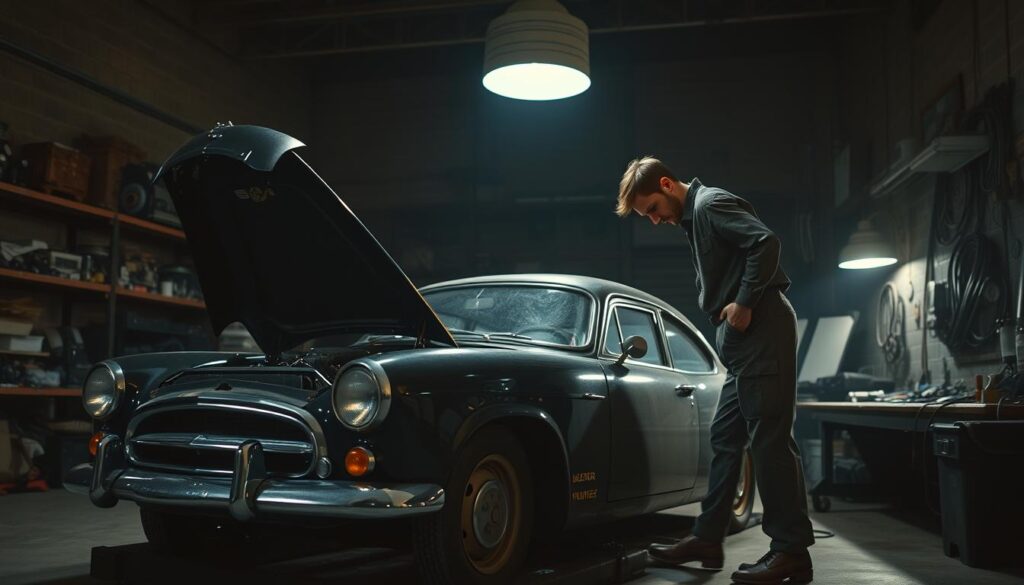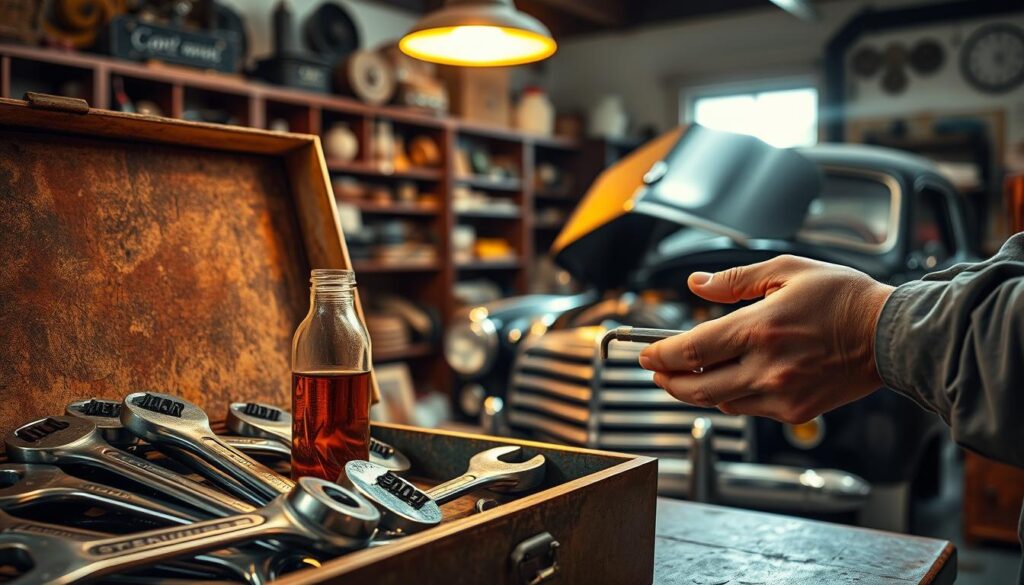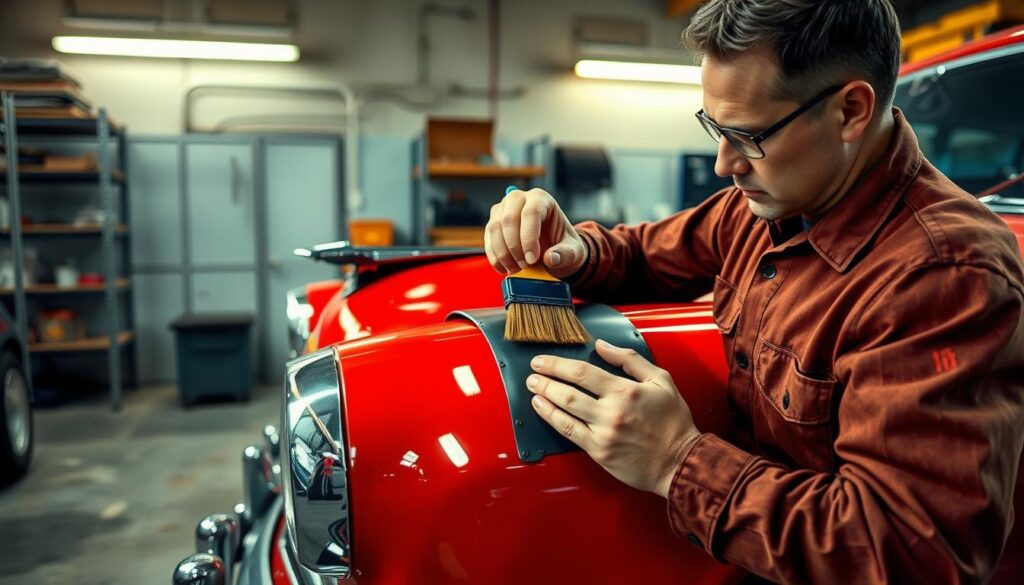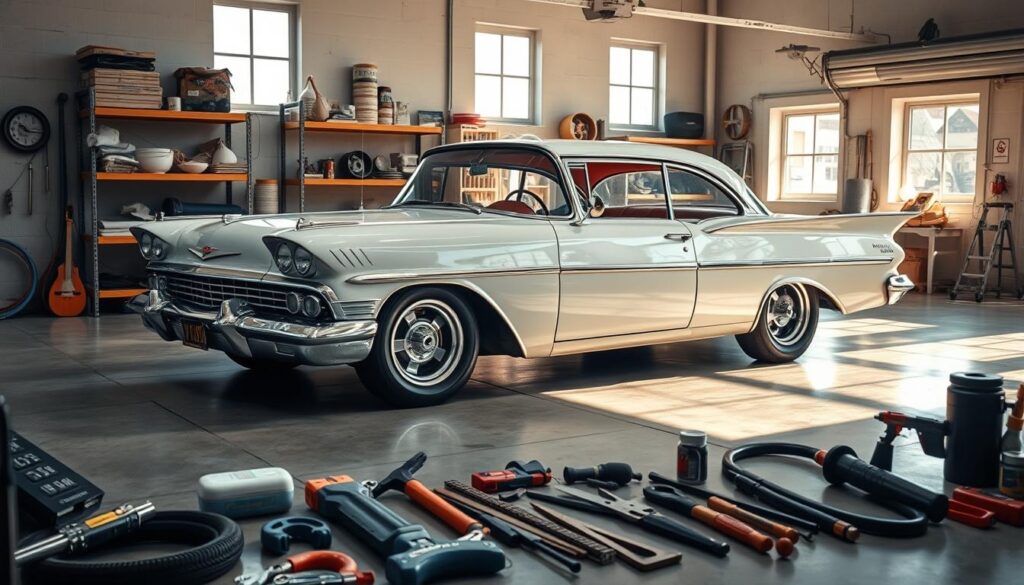How to Maintain a Vintage Car
Did you know a well-preserved classic car can appreciate in value by over 500% in a single decade? That’s the incredible potential resting in your garage. This guide welcomes you to the rewarding world of preserving these rolling pieces of history.
Owning an older vehicle is a unique passion. It comes with challenges you won’t find with modern models. These automotive treasures demand special attention and a different kind of care.
Regular upkeep is about more than just keeping it running. It protects your investment’s monetary worth and stunning appearance. Consistent care ensures your prized possession remains roadworthy and beautiful for years.
These automobiles require a distinct approach. Older technology, rare parts, and different construction methods mean standard maintenance won’t suffice. This guide will walk you through preventive measures, routine checks, and expert preservation techniques.
Whether you’re a new collector or a seasoned enthusiast, following a dedicated routine is deeply satisfying. It connects you to your vehicle’s history. Let’s explore how to keep your classic running smoothly for the next generation.
Key Takeaways
- Proper care can significantly increase a classic automobile’s financial value over time.
- Older vehicles have unique needs compared to modern cars, requiring specialized knowledge.
- Regular maintenance is essential for preserving both the mechanical function and visual appeal.
- A consistent care routine is key to ensuring the vehicle remains safe and driveable.
- This guide provides practical steps for both new and experienced owners to protect their investment.
Understanding the Basics of Vintage Car Maintenance

Caring for an older vehicle is less about convenience and more about preservation. These automobiles were built with different materials and standards. This fundamental difference dictates a specialized approach to their upkeep.
Key Considerations for Classic Car Care
Why do these vehicles demand more attention? Older components are often less tolerant of neglect. Simple gaskets and seals can dry out, and fluids degrade faster over time.
Preventive care is your best strategy. Catching a small leak early can save you from a major repair bill later. This proactive mindset is the core of successful preservation.
Establishing a Regular Maintenance Routine
The secret to longevity is a consistent schedule. For cars driven fewer than 1,500 miles a year, time is more critical than distance. Engine oil, for instance, should be changed every six months, regardless of mileage.
Create a simple calendar for your car. Note seasonal checks and monthly tasks. This personalized plan ensures nothing is overlooked.
Driving your classic regularly is vital. A monthly drive keeps tires, belts, and seals from deteriorating due to inactivity. It also helps circulate fluids and charge the battery.
Maintenance Schedule Comparison
| Maintenance Type | Primary Trigger | Key Focus | Best For |
|---|---|---|---|
| Time-Based | Months/Seasons | Preventing age-related decay | Low-mileage classic cars |
| Mileage-Based | Distance Driven | Addressing wear from use | Modern daily driver vehicles |
This routine protects your investment. It preserves originality and prevents premature aging. Consistent care keeps your prized possession ready for the road.
How to Maintain a Vintage Car: Step-by-Step Guide

Following a detailed checklist before each drive can prevent unexpected issues and maintain optimal function. This systematic approach ensures every critical component receives proper attention.
Checking Fluids and Engine Performance
Start by verifying all essential fluids. Check the oil, coolant, power-steering fluid, and windshield wiper reservoir. Always make sure the oil level is adequate before driving.
If the oil drops by half a quart or more, top it off immediately. Change both the oil and filter annually, regardless of mileage. This protects your engine from unnecessary wear.
Transmission fluid requires special attention. Check it after driving when the engine is warm for accurate readings. Watch for metal shavings when changing this fluid and differential oil.
Inspecting Brakes, Tires, and Electrical Components
Test your brakes before venturing far from home. Squishy pedal feel indicates potential problems. Check underneath the vehicle for brake fluid leaks.
Your brake fluid should resemble apple juice in color. If it appears dark or contaminated, replacement is necessary. Have brakes bled twice yearly and inspect pads for uneven wear.
Examine tire tread, pressure, and rubber condition thoroughly. Check sidewall date codes since tires safely last six to ten years. Age often matters more than appearance for safety.
Listen carefully when starting your vehicle. Slow cranking suggests battery issues. Regular electrical system checks prevent unexpected failures during drives.
Preventing Rust and Corrosion in Your Classic Car

Rust is the silent enemy that can slowly destroy even the most beautiful classic automobile. This destructive process starts small but can spread quickly if left unchecked. Proper prevention strategies are essential for long-term preservation.
The right storage environment makes all the difference. A warm, dry garage provides excellent protection against moisture-related problems. This simple step goes a long way in keeping rust at bay.
Best Practices for Effective Storage and Cleaning
Ideal storage means a concrete floor in a climate-controlled space. Look for a garage with good ventilation and temperature regulation. Avoid parking on dirt or grass where moisture collects underneath.
Regular cleaning prevents dirt buildup that traps moisture. Wash your car every few weeks if driven occasionally. During cold weather, increase washing to weekly to remove road salt.
Handwashing with microfiber cloths protects delicate components. Use a garden hose for rinsing—avoid power washers that can strip protective coatings. Pay special attention to wheel arches and undercarriage areas where dirt accumulates.
After winter driving, thoroughly rinse tires and undercarriage to prevent surface rust. Treat any existing rust spots with quality lubricant before storage. This stops corrosion from spreading during extended storage time.
Following these practices protects your investment and preserves that beautiful paint finish. Consistent care ensures your classic remains corrosion-free for years to come.
Essential Fluids and Parts for Optimal Performance

Choosing the correct lubricants and parts ensures your prized possession runs smoothly for decades. The right selections protect your investment and prevent costly repairs.
Selecting the Right Oil and Gasoline
Ethanol-free recreational gas is superior for collector automobiles. Standard unleaded gasoline can damage older fuel systems over time.
Keep your fuel tank at least half full. This prevents condensation buildup and protects the fuel pump from premature failure.
Conventional oil is often better than synthetic for vintage engines. Choose the proper viscosity rating specified for your specific vehicle.
Maintaining Brake Fluid, Coolant, and Other Components
Flush the cooling system annually with fresh 50/50 coolant and distilled water. This prevents corrosion and maintains optimal engine temperature.
Ball joints connect the control arm to the steering knuckle. Inspect them at every oil change service for proper lubrication.
Well-greased joints can last a lifetime. Dry components fail quickly and require expensive replacements.
Fluid Maintenance Guide
| Fluid Type | Maintenance Frequency | Key Benefit |
|---|---|---|
| Engine Oil | Every 6 months | Prevents engine wear |
| Coolant | Annual flush | Prevents overheating |
| Brake Fluid | Twice yearly | Ensures braking power |
| Fuel System | Keep tank half full | Prevents pump issues |
Lubricate drive-line components like u-joints regularly. Inspect and repack wheel bearings during major service intervals for smooth operation.
Expert Tips for Preserving Your Classic Car’s Value

The true value of a vintage automobile lies not just in its appearance but in its originality. Smart collectors understand that authenticity drives long-term worth more than any modification.
Keeping It Original and Avoiding Unnecessary Modifications
Resist the temptation to modernize your classic car. Original factory specifications matter most to serious buyers. Even small changes can significantly reduce your vehicle’s collector appeal.
When repairs become necessary, research original stock parts specific to your model. Using period-correct components maintains authenticity and protects investment potential. Modern alternatives may seem convenient but often decrease value.
Protect your paint with quality wax products designed for longevity. Some hard waxes can shield your finish for up to six months. Regular waxing creates a barrier against environmental elements while enhancing appearance.
Never underestimate tire safety. Replace tires every six years regardless of tread depth. Aged rubber poses serious risks—a blowout can damage your vehicle and endanger lives.
Treat interior materials with respect to preserve vinyl and cloth surfaces. Regular vacuuming prevents dirt buildup that traps moisture. This simple habit maintains cabin condition and prevents premature deterioration.
Conclusion
Owning a piece of motoring heritage brings immense satisfaction when you follow proven preservation methods. Your dedication to regular car maintenance protects both the appearance and mechanical condition of your prized possession.
Remember that consistent care prevents most problems before they start. Regular checks of oil, fluid levels, brakes, and tires save time and money on future repair work. Proper storage in a dry garage and cleaning to remove dirt fight corrosion effectively.
Keep your classic car original with period-correct parts, and don’t hesitate to seek professional auto help for complex tasks. Following these guidelines ensures your vehicle remains road-ready for many years to come.
FAQ
How often should I drive my classic car?
What is the best way to store a vintage vehicle long-term?
Can I use modern synthetic oil in my vintage engine?
How do I protect my classic car’s paint and prevent rust spots?
Are reproduction parts as good as original components for repair?
What’s the most common mistake new owners make with their classic cars?

Adam Peter is a finance, travel, and automotive writer with over a decade of experience. He creates clear, practical content to help readers manage their money, explore the world with confidence, and make informed decisions about cars and travel gear. His work blends expert insight with real-world usefulness.




